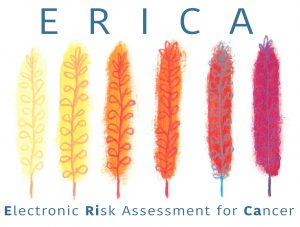What is the clinical-effectiveness and cost-effectiveness of embedded risk-of-cancer assessment of patients in primary care: the ERICA trial
Start Date Jun 2019
Code E11-Aff
Status Ongoing
An estimated 10,000 annual UK cancer deaths would not occur if the UK matched the outcomes of other European countries. Most of the difference relates to diagnostic delay. The NHS Long Term Plan, published in January 2019, specifically targets an increase in the percentage of cancer patients who are diagnosed at stage 1 or 2 (curable) from the current 54% to 75% by 2028. This requires major changes in the way cancer is diagnosed.
Within general practice, where the core problem exists of identifying the patient who may have cancer, there has been an enormous increase in research efforts. This includes studies that aimed to identify which symptoms of possible cancer actually matter. The main outputs from this work have been the development of Risk Assessment Tools (or RATs). These give percentage estimates of the chance of an underlying cancer in the presence of specific symptoms, e.g. for single symptoms (for example the risk of lung cancer with coughing blood is 2.4%), as pairs of symptoms (coughing blood accompanied by loss of weight is 9.2%) or as repeated symptoms (a re-attendance with coughing blood is 17%).
RATs have been published for 18 of the most common cancers, accounting for nearly 90% of the total cancer burden and this work strongly underpinned the NICE 2015 guideline revision. The initial versions were in paper, mouse mat, calendar, or web-based forms – they increased cancer diagnostic activity but the formats did not allow close integration with GPs clinical systems. In partnership with Macmillan, the UK cancer charity, electronic versions for seven major cancers (lung, colorectal, pancreas, oesophago-gastric, ovary, bladder and kidney) have been developed. These eRATs have been integrated into clinical software for two of the main UK GP software providers, with two other major providers almost ready to host them. The eRATs prompt the GP when the risk of one or more of these cancers is above two percent.
A pilot feasibility trial of the oesophago-gastric eRAT is currently underway. However, findings from this study will be restricted to this single eRAT and crucial questions regarding the clinical effectiveness and usability of multiple eRATs will remain.
One major aspect of the eRAT research that is outstanding relates to cost-effectiveness – there is very little health economic evidence to date. This is crucial as annual NHS spending on cancer diagnosis is approximately £1bn. Observational data suggests that expedited cancer diagnosis may be clinically effective but there is no data to examine cost-effectiveness. What work has been published has been judged to be of very poor quality or simplistic. With funding from the Dennis and Mireille Gillings Foundation, the ERICA trial is a carefully designed clinical trial that aims to address the following question – what is the clinical effectiveness and cost-effectiveness of electronic decision support embedded within primary care IT systems in the early diagnosis of symptomatic cancer?
Aims & objectives
The overarching aim of ERICA is to assess the clinical effectiveness and cost-effectiveness of six eRATs (lung, oesophago-gastric, kidney, bladder, ovarian, and colorectal cancer) compared to usual care for patients in general practice. The specific objectives of the study are to compare the effects of eRATs vs usual care on:
- cancer staging at the time of diagnosis
- cost to the NHS
- patient experience of care
- service delivery
Methodology
The trial aims to recruit 530 practices across England. Practices who join the trial will be randomly allocated to either the intervention arm, where they will receive access to the suite of eRATs, or to the control arm, where they will provide their usual care.
The primary outcome is whether a patient diagnosed with one of the six cancers during the follow-up period is diagnosed at stage 1/2 (early – cure likely) or stage 3/4 (late – cure not likely). Secondary outcomes include an examination of the different routes through which patients get diagnosed (e.g. two-week wait, GP referral) and 30-day and one-year survival rates.
Outputs & impacts
Key outputs from the trial will be presentations at national and international conferences, seminars, PPI events and dissemination through internationally recognised peer-reviewed journal publications, newsletters and media releases.
The eRATs are, in principle, already available to a large number of GP practices. Outcomes indicating that the eRATs help GPs catch cancer sooner may lead to an increase in the uptake of clinical decision support tools.
Next steps
The trial started in June 2019 with practice recruitment from then until December 2019. Practices will be in the trial for approximately 2 years, with the data collection phase closing in December 2021. Final data should be available from the Cancer Registry around December 2022 with analyses and write up planned until the end of the project in August 2023.
Publications
- Ward T, Medina-Lara A, Mujica-Mota RE, Spencer AE. Accounting for Heterogeneity in Resource Allocation Decisions: Methods and Practice in UK Cancer Technology Appraisals. Value Health, 2021; Jul;24(7):995-1008. doi: 10.1016/j.jval.2020.12.022.



